#meta-digital affects of control
Explore tagged Tumblr posts
Text
A lawsuit filed Wednesday against Meta argues that US law requires the company to let people use unofficial add-ons to gain more control over their social feeds.
It’s the latest in a series of disputes in which the company has tussled with researchers and developers over tools that give users extra privacy options or that collect research data. It could clear the way for researchers to release add-ons that aid research into how the algorithms on social platforms affect their users, and it could give people more control over the algorithms that shape their lives.
The suit was filed by the Knight First Amendment Institute at Columbia University on behalf of researcher Ethan Zuckerman, an associate professor at the University of Massachusetts—Amherst. It attempts to take a federal law that has generally shielded social networks and use it as a tool forcing transparency.
Section 230 of the Communications Decency Act is best known for allowing social media companies to evade legal liability for content on their platforms. Zuckerman’s suit argues that one of its subsections gives users the right to control how they access the internet, and the tools they use to do so.
“Section 230 (c) (2) (b) is quite explicit about libraries, parents, and others having the ability to control obscene or other unwanted content on the internet,” says Zuckerman. “I actually think that anticipates having control over a social network like Facebook, having this ability to sort of say, ‘We want to be able to opt out of the algorithm.’”
Zuckerman’s suit is aimed at preventing Facebook from blocking a new browser extension for Facebook that he is working on called Unfollow Everything 2.0. It would allow users to easily “unfollow” friends, groups, and pages on the service, meaning that updates from them no longer appear in the user’s newsfeed.
Zuckerman says that this would provide users the power to tune or effectively disable Facebook’s engagement-driven feed. Users can technically do this without the tool, but only by unfollowing each friend, group, and page individually.
There’s good reason to think Meta might make changes to Facebook to block Zuckerman’s tool after it is released. He says he won’t launch it without a ruling on his suit. In 2020, the company argued that the browser Friendly, which had let users search and reorder their Facebook news feeds as well as block ads and trackers, violated its terms of service and the Computer Fraud and Abuse Act. In 2021, Meta permanently banned Louis Barclay, a British developer who had created a tool called Unfollow Everything, which Zuckerman’s add-on is named after.
“I still remember the feeling of unfollowing everything for the first time. It was near-miraculous. I had lost nothing, since I could still see my favorite friends and groups by going to them directly,” Barclay wrote for Slate at the time. “But I had gained a staggering amount of control. I was no longer tempted to scroll down an infinite feed of content. The time I spent on Facebook decreased dramatically.”
The same year, Meta kicked off from its platform some New York University researchers who had created a tool that monitored the political ads people saw on Facebook. Zuckerman is adding a feature to Unfollow Everything 2.0 that allows people to donate data from their use of the tool to his research project. He hopes to use the data to investigate whether users of his add-on who cleanse their feeds end up, like Barclay, using Facebook less.
Sophia Cope, staff attorney at the Electronic Frontier Foundation, a digital rights group, says that the core parts of Section 230 related to platforms’ liability for content posted by users have been clarified through potentially thousands of cases. But few have specifically dealt with the part of the law Zuckerman’s suit seeks to leverage.
“There isn’t that much case law on that section of the law, so it will be interesting to see how a judge breaks it down,” says Cope. Zuckerman is a member of the EFF’s board of advisers.
John Morris, a principal at the Internet Society, a nonprofit that promotes open development of the internet, says that, to his knowledge, Zuckerman’s strategy “hasn’t been used before, in terms of using Section 230 to grant affirmative rights to users,” noting that a judge would likely take that claim seriously.
Meta has previously suggested that allowing add-ons that modify how people use its services raises security and privacy concerns. But Daphne Keller, director of the Program on Platform Regulation at Stanford's Cyber Policy Center, says that Zuckerman’s tool may be able to fairly push back on such an accusation.“The main problem with tools that give users more control over content moderation on existing platforms often has to do with privacy,” she says. “But if all this does is unfollow specified accounts, I would not expect that problem to arise here."
Even if a tool like Unfollow Everything 2.0 didn’t compromise users’ privacy, Meta might still be able to argue that it violates the company’s terms of service, as it did in Barclay’s case.
“Given Meta’s history, I could see why he would want a preemptive judgment,” says Cope. “He’d be immunized against any civil claim brought against him by Meta.”
And though Zuckerman says he would not be surprised if it takes years for his case to wind its way through the courts, he believes it’s important. “This feels like a particularly compelling case to do at a moment where people are really concerned about the power of algorithms,” he says.
370 notes
·
View notes
Text
a vast methodical fragment

(this is a cross post from cohost. pretty much all my stuff ends up there first. that said! writing here is what initially led to me getting a job as professional critic so some stuff will still end up here)
i am playing Final Fantasy 7: Rebirth. no spoilers in this post! don't panic! though I have seen the ending and will eventually write on What This Remake Business Is Even About Now I'm taking a slower recircling back through the world and doing side content. because this is a good world. that's maybe the biggest strength of the entire game! there's a remarkable sense that the world has been as well-considered as the characters. part of what makes the remake trilogy feel more solid than something like final fantasy 16 is the ways in the texture added into every location. final fantasy 16 had a lot of maps and lore and codex entries that were meant to create a sense of "realness" to Valisthea but the sum total of that falters compared to even some of Rebirth's smallest moments. no timeline, however meticulous, can compare to watching protesters in lower Junon wave signs outside of the Shinra-controlled entrance to the city or seeing how bars are themed in the Gold Saucer.
when I wrote about the end of Final Fantasy 16I made comparisons to Triangle Strategy. both games tackled similar matters on paper but in practice, I felt that the latter succeeded because it had an understanding of its settings material realities. In their podcast on ff16, the folk at Abnormal Mapping (I think specifically Austin as the guest third chair) noted that while the game had aspirations about tackling slavery, it only ever really showed Bearers being used for servant work. they aired out laundry or lit fireplaces. it belied a certain lack of consideration for the world and its needs why is someone airing out laundry with magick when they could be cultivating a field? yes, Titan is a great summon useful in war but would his existence not affect the Dhalmekian Republic's infrastructure and architecture?
Rebirth doesn't have this issue. Walking in any town or exploring the outlying regions starts readily reveals locations that have a great deal of consideration and consistency. I know where the food come from, I can stumble in on teachers reading stories to classes or else telling them some local folklore. there are popular songs, i run into veterans of old wars and stumble on abandoned forts that still have old ammo boxes in them, local superstitions and phrases. the pieces fit together.
I've quibbles with Rebirth in the sense that I think it's a bit distracted as a story. there are times when the larger sound and fury threaten to signify nothing and I don't think that's simply to do with the fact that it's adapting a fairly freewheeling portion of the 1997 original. but that's a very particular complaint targeted at the meta-narrative. What Is This All About?
for the moment, i'm content putting that question on hold. the contrast to ff16 is perhaps what's ringing most loudly in my mind. this is a world with wave-race dolphin riding, combat simulators where an android named Chadley digitizes local gods into pocket-sized summon materia. it's a place where your ninja friend accidentally creates countless copies of a joke-character and they all team up to renovate a seaside inn. but I take it more seriously.
a jaded person might say that it had that grace built in because of my nostalgia but the truth it that earned this consideration through the care built into the world. it didn't make demands of me. the developers looked at the world, asked how it would work and wove that into everything. i know the latest gimmick popsicle flavors for crying out loud!
the difference between a heap of lore and a properly built world can be thin and arbitrary but if there's one thing I really appreciate from this ongoing Remake project, it's the how much the player understands How It Got The Way It Is.
#final fantasy vii remake#final fantasy vii rebirth#ffvii rebirth#ffvii remake#casual game crit#worldbuilding
7 notes
·
View notes
Text
The Importance of On-Page SEO: Boosting Your Website's Visibility
In the ever-evolving landscape of digital marketing, search engine optimization (SEO) remains a cornerstone strategy for enhancing online visibility and driving organic traffic to websites. While SEO encompasses a broad range of practices, on-page SEO is particularly crucial as it directly influences how search engines interpret and rank your content. In this blog post, we'll explore the importance of on-page SEO and how it can significantly impact your website's performance.
Understanding On-Page SEO
On-page SEO refers to the optimization techniques applied directly to the content and HTML source code of a webpage. Unlike off-page SEO, which involves external signals like backlinks, on-page SEO is entirely within your control. It includes optimizing elements such as meta tags, headings, content quality, internal links, and URL structure to improve your website's search engine rankings and user experience.
Key Elements of On-Page SEO
Title Tags: The title tag is one of the first things search engines and users see. A well-crafted title tag that includes relevant keywords can significantly improve your click-through rate (CTR) and rankings.
Meta Descriptions: While meta descriptions don't directly affect rankings, they influence CTR. A compelling meta description can entice users to click on your link, boosting your organic traffic.
Headings (H1, H2, H3, etc.): Proper use of headings helps search engines understand the structure and relevance of your content. It also enhances readability for users, making your content more engaging.
Content Quality: High-quality, relevant content is the cornerstone of on-page SEO. Content should be informative, engaging, and optimized with the right keywords to meet the needs of your target audience.
Keyword Optimization: Incorporating relevant keywords naturally within your content helps search engines understand the topic and context of your page. However, avoid keyword stuffing, as it can harm your rankings.
Internal Linking: Linking to other pages within your website helps search engines crawl your site more effectively and establishes a hierarchy of information, improving the user experience.
URL Structure: Clean, descriptive URLs that include keywords can improve your site's visibility and make it easier for users to navigate.
Image Optimization: Optimizing images by using descriptive file names, alt tags, and compressing files can improve your page load speed and make your site more accessible.
Benefits of On-Page SEO
Improved Search Engine Rankings: By optimizing on-page elements, you increase the likelihood of your content ranking higher in search engine results pages (SERPs). Higher rankings lead to more visibility and traffic.
Enhanced User Experience: On-page SEO practices, such as improving site speed and creating engaging content, contribute to a better user experience. Satisfied visitors are more likely to stay longer, reducing bounce rates and increasing conversions.
Increased Organic Traffic: Effective on-page SEO helps attract more organic traffic by making your content more visible and relevant to search queries. This leads to a steady stream of visitors without the need for paid advertising.
Higher CTR: Well-optimized title tags and meta descriptions can improve your CTR, driving more traffic to your site from search engines.
Better Conversion Rates: By providing a seamless and enjoyable user experience, on-page SEO can lead to higher conversion rates, turning visitors into customers or subscribers.
Conclusion
On-page SEO is an essential component of a successful digital marketing strategy. By paying attention to the elements within your control, you can significantly improve your website's visibility, user experience, and overall performance. Investing time and effort into on-page SEO not only enhances your search engine rankings but also drives sustainable, long-term growth for your online presence. Start optimizing today and watch your website soar to new heights!
2 notes
·
View notes
Text
#OneNETnewsINVESTIGATES: Bleach Fandom Community on The X Network face Massive Death Threats and Harassments, targeting animators at a Japanese anime studio [EXCLUSIVE]

TRIGGER WARNING: The following investigative news report contains a higher dose of extra severe graphic nature and anime culture issues. Our news organization of OneNETnews has a STRICT zero-tolerance policy and we do NOT fully promote, aggressively attacking or condone to expose the hate in a political matter. Read our IMPORTANT DISCLAIMER in this news article below, mga-Kabandera.
TOKYO, JAPAN -- In a brazen but saddened turn of events, fans of the popular anime series 'Bleach' have recently taken to the X Network (formerly Twitter) unleashing a barrage of death threats, harassments and a brazen cesspool of hate speech against animators from Studio Pierrot, following the release of 'Bleach: Thousand-Year Blood War'. The Japanese animators' safety and well-being have been seriously affected by these toxic actions with corrupted anime production. Sport entertainment, pop culture and the digital insider 'Sportskeeda' obtained the exclusive investigative insights into this disturbing trend to expose political hatred of anime, shedding light on the impact of these threats and the potential ramifications for the future of the beloved anime.

(FILE PHOTO COURTESY: Google Images)
To comprehend this distasteful tragedy, it's essential to understand the significance of Bleach within anime. Bleach is a renowned anime and manga series created by Mr. Noriaki Kubo.

A male protagonist teen with ghost-seeing abilities, Ichigo Kurosaki is assigned the role of Soul Reaper, a soul-guiding agent who protects the living world from evil spirits of hell. A mix of action, supernatural elements and intricate storytelling captivated audiences worldwide, since its debuted on television originally from Japan.

The latest installment 'Bleach: Thousand-Year Blood War' in the early mid-October 2022 -- marked the return of the series, after a long hiatus from late-March 2012, much to the delight of the fans. However, as the show progressed, a faction of disgruntled fans began expressing their dissatisfaction on social media platforms such as the X Network and Threads (who were individually owned by the X Corporation and Meta Platforms Inc.), specifically targeting all animators associated with Studio Pierrot in the aforesaid home country of Tokyo Prefecture.

An animation director of 'Bleach: Thousand-Year Blood War' named Satoshi Sakai, became entangled in this virtual controversy. Although under immense pressure and risk, Sakai and others at Studio Pierrot wasn't publicly issued an apology or taken any drastic steps to halt production of the new sequel.
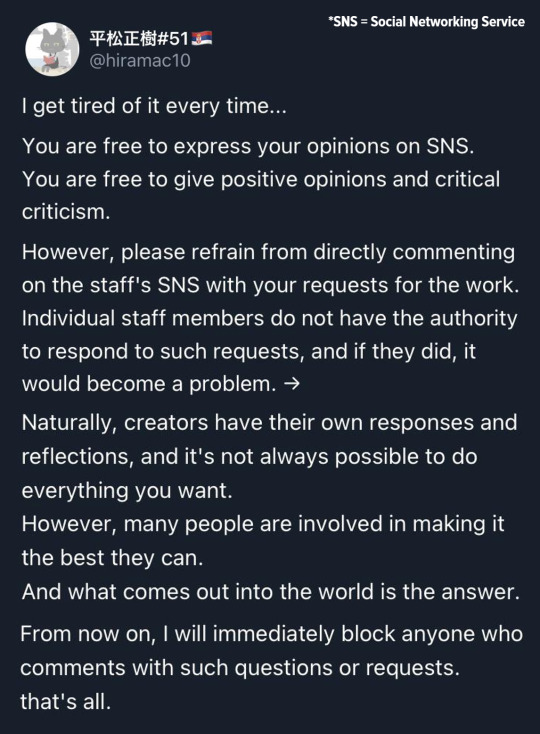
(SCREENGRAB COURTESY: The X Network, formerly Twitter)
One theory surrounding Sakai's decision by refusing to apologize or cancel the anime sequel suggests that the animators and Studio Pierrot are caught in a difficult predicament. While the threats and harassment are unjustifiable and reprehensible, some speculate that a public apology or cancellation could set a dangerous precedent for creators worldwide. It could embolden extremist fans to a rudeful, weaponize threats and harassments to exert control over the creative direction of their favorite series.

Moreover, Studio Pierrot may also be reluctant to abandon the 'Bleach' franchise altogether, regardless the movie or anime TV series. Bleach has been a significant source of revenue for the studio, and ending it abruptly could have severe financial consequences. Additionally, the studio may believe that addressing the toxic behavior through proper channels, such as reporting it to law enforcement and social media platforms, is a more responsible approach to handling the situation.
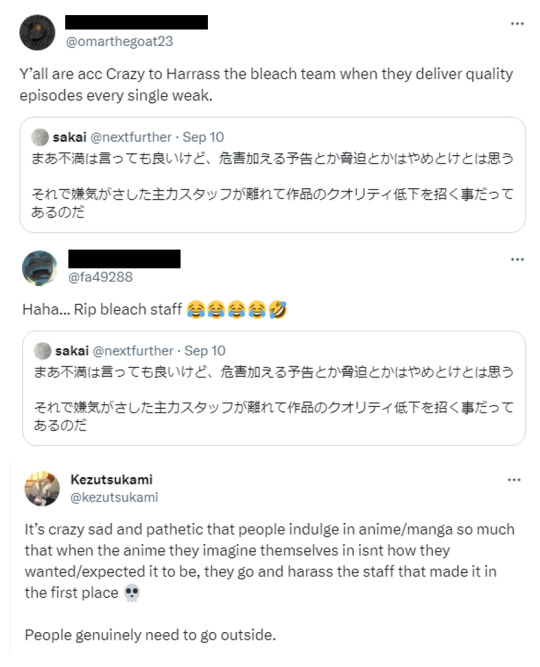
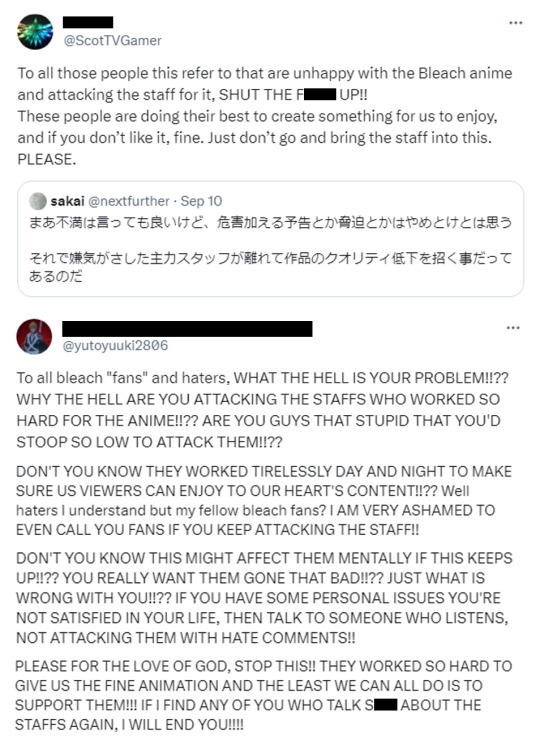
(SCREENGRAB COURTESY: The X Network, formerly Twitter)
The conventional crisis was garnered its Western attention, with international fans and fellow industry professionals expressing their support for the animators and condemning the harassment. However, as this situation unfolds, it raises critical questions about the state of cancelled culture and the responsibility of online social media platform like the X Network, to address this abusive behavior.

In light of these developments, the anime fandom of 'Bleach' is at a crossroads. There are many former and current anime fans at present -- who still cherish the series and the creators, however a vocal minority threatens to overshadow the positive aspects of the anime community due to their actions. The future of 'Bleach' and the well-being of its animators hang in the balance, as the world watches to see how this disturbing chapter unfolds.
POSTER and STOCK PHOTO COURTESY for REPRESENTATION: Studio Pierrot & Google Images BACKGROUND PROVIDED BY: Tegna
A big SPECIAL THANKS to Srinjoy Ganguly & Apratim Chakraborty of Sportskeeda for contributing this investigative news report.
SOURCE: *https://www.sportskeeda.com/anime/news-bleach-fandom-comes-support-creators-lives-threatened [Referenced News Article #1 via Sportskeeda] *https://www.sportskeeda.com/anime/bleach-animators-face-death-threats-following-tybw-episode-22-release [Referenced News Article #2f via Sportskeeda] *https://animehunch.com/bleach-tybw-staff-express-concern-over-harassment-threats-made-by-disgruntled-fans-full-story/ [Referenced News Article via Anime Hunch] *https://twitter.com/nextfurther/status/1700675112142524894 [Referenced Tweeted Post #1 via The X Network] *https://twitter.com/nextfurther/status/1700676134634197198 [Referenced Tweeted Post #2f via The X Network] *https://old.reddit.com/r/bleach/comments/16ep0fm/apparently_some_bleach_animators_have_been/ *https://old.reddit.com/r/bleach/comments/16ltgs0/bleach_tybw_staff_express_concern_over_harassment/ *https://desuarchive.org/a/thread/257047007/ [Referenced Archived Forum Thread #1 via 4chan] *https://desuarchive.org/a/thread/257109286/ [Referenced Archived Forum Thread #2 via 4chan] *https://desuarchive.org/a/thread/257146673/ [Referenced Archived Forum Thread #3f via 4chan] *https://www.youtube.com/watch?v=qlsfkT_PJOQ [Referenced YT Video via KitoSenpai] *https://www.youtube.com/watch?v=NtyPBXt5hwQ [Referenced YT Video via OutOfJapan] *https://www.youtube.com/watch?v=OkpgCx0p4qU [Referenced YT Video via Hero Hei] *https://www.youtube.com/watch?v=yF3yzKcVPJ8 [Referenced YT Video via Jaymes Hanson] *https://www.youtube.com/watch?v=Rwo3sQCCcJU [Referenced YT Video via DZBimran] *https://en.wikipedia.org/wiki/Bleach_(TV_series) *https://ja.wikipedia.org/wiki/ぴえろ *https://help.twitter.com/en/rules-and-policies/abusive-behavior [Referenced ToS Section Rule via Twitter] *https://www.cbr.com/tite-kubo-bleach-creator-trivia-fun-facts/ [Referenced Biography Article via Comic Book Resource] and *https://www.animenewsnetwork.com/encyclopedia/people.php?id=49963 [Referenced Biography via Anime News Network]
IMPORTANT HONEST DISCLAIMER: The readers and opinions expressed from this Investigative News Report are not necessarily those of Studio Pierrot and X Corporation. These online toxicity suspects on social media will not be imitated in any political matter, as to be later enforced in the Anti-Cybercrime Division of America. Furthermore, the assumptions of this I.N.R. will NOT state, intervene, or reflect those of our Radyo Bandera Patrol news reporters. The show, the station, the management, interwebs, and the network. Thanks for reading and stay safe, mga ka-Bandera!!!
-- OneNETnews Team
#entertainment news#tokyo#japan#studio pierrot#bleach#bleach spoilers#anime#death threats#anger#police report#online harassment#animators#sequel#thousand-year blood war#investigates#exclusive#first and exclusive#OneNETnews
2 notes
·
View notes
Text
Boost Your Digital Marketing Success: The Ultimate Guide to SEO
Boosting your digital marketing success through SEO (Search Engine Optimization) is crucial in today's online landscape. SEO helps your website rank higher on search engine results pages (SERPs), increasing visibility, traffic, and conversions.
In a digital world that never sleeps, you need more than just a website; you need an online strategy that stands out. At techshek, they craft compelling narratives, design captivating visuals, and engineer strategies that drive engagement and conversion. It's time to rise above the digital noise.
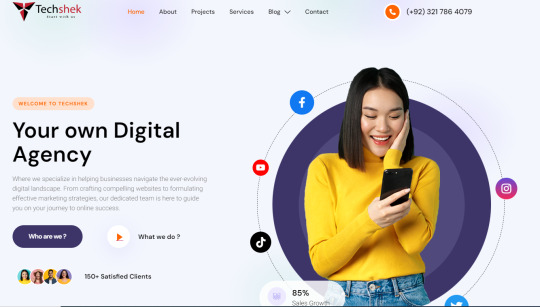
Digital marketing is a dynamic and competitive field, and to thrive in it, your digital agency needs to be at the top of its game. The digital marketing landscape is constantly evolving. New technologies, algorithms, and consumer behaviors emerge regularly. To remain competitive, your agency must stay informed about the latest industry trends.
This ultimate guide will walk you through the key aspects of SEO to help you achieve better results.
1. Understanding SEO Basics:
a. Keywords:
Keyword Research: Identify relevant keywords that your target audience uses when searching for products or services.
Long-Tail Keywords: Focus on specific, less competitive keywords that can drive high-quality traffic.
b. On-Page SEO:
Title Tags: Create unique, descriptive titles for each page, including target keywords.
Meta Descriptions: Write compelling meta descriptions with keywords to entice clicks.
Header Tags: Use H1, H2, and H3 tags to structure your content and include keywords.
Keyword Optimization: Incorporate keywords naturally in content, but avoid keyword stuffing.
Image Optimization: Optimize images with descriptive file names and alt text.
c. Content Quality:
High-Quality Content: Create informative, engaging, and valuable content that answers user queries.
Content Length: Aim for comprehensive, in-depth content where appropriate.
Fresh Content: Update and add new content regularly to keep your site relevant.
d. User Experience (UX):
Mobile Optimization: Ensure your website is mobile-friendly and responsive.
Page Load Speed: Optimize loading times for better user experience.
User-Friendly Design: Make navigation easy, and use clear calls to action.
2. Off-Page SEO:
a. Backlinks:
Quality Backlinks: Build high-quality, relevant backlinks from reputable websites.
Guest Blogging: Write guest posts on authoritative sites in your niche.
Social Signals: Engage on social media platforms to boost brand visibility.
b. Local SEO:
Google My Business: Claim and optimize your Google My Business listing for local searches.
Local Citations: Consistency in business name, address, and phone number (NAP) across online directories.
3. Technical SEO:
a. Site Structure:
XML Sitemap: Create and submit an XML sitemap to search engines.
URL Structure: Keep URLs clean, concise, and relevant to the page content.
b. Website Security:
HTTPS: Secure your site with an SSL certificate for data encryption.
Mobile-Friendly: Ensure your site performs well on mobile devices.
c. Indexation and Crawling:
Robots.txt: Use robots.txt to control which parts of your site search engines can crawl.
XML Sitemap: Include important pages in your sitemap for indexing.
4. Monitoring and Analytics:
a. Google Analytics:
Set up Google Analytics to track website traffic, user behavior, and conversions.
b. Google Search Console:
Monitor your website's performance in Google Search and resolve issues.
5. Content Promotion:
a. Social Media:
Share your content on social media platforms to increase visibility and engagement.
b. Email Marketing:
Send newsletters and updates to your email subscribers to promote new content.
6. Regular SEO Audits:
Conduct regular SEO audits to identify and address issues affecting your site's performance.
7. Stay Updated:
SEO is constantly evolving. Keep abreast of industry trends and algorithm updates.
8. Seek Professional Help:
Consider hiring an SEO expert or agency if you lack the time or expertise to manage SEO effectively.
Techshek stands out for its diverse range of services that cover every aspect of establishing and maintaining a strong online presence. From crafting visually appealing websites to implementing data-driven SEO strategies, they offer a comprehensive suite of solutions tailored to your unique needs.
Experience accelerated growth and productivity as they handle your digital endeavors, leaving you free to focus on your core business strategies. They pride themselves on crafting the best-in-class strategies tailored to your business objectives.
4 notes
·
View notes
Text
What Is Crawling?

When it comes to SEO (Search Engine Optimization), one of the most crucial yet often overlooked processes is crawling. Whether you’re running a personal blog, a business website, or an online store, understanding how crawling works can greatly impact your website's visibility in search engine results. But what exactly is crawling, and why does it matter?
In this blog, we'll break down what crawling is, how it works, and why it’s important for your SEO strategy. We'll also explain how a Digital marketing agency in Tamil Nadu can help you optimize your website for better crawling and indexing.
What Is Crawling?
Crawling is the process by which search engines like Google use automated bots (also known as crawlers or spiders) to explore and index the content of websites. Crawlers follow links on the web, starting from a set of known pages (seed URLs) and moving through the site by following hyperlinks. They gather information about the content of each page, such as text, images, and meta tags.
Why Is Crawling Important for SEO?
Search engines like Google rely on crawlers to discover new and updated content on the web. Here’s why crawling is essential for your website's SEO:
Indexing: Crawlers are responsible for adding your pages to a search engine’s index. If a page is not crawled, it will not appear in search engine results.
Website Visibility: Websites that are easily crawlable have a better chance of appearing in search engine results, driving more organic traffic.
Ranking: The more crawlers can access and understand your website’s content, the better your pages can be ranked for relevant search queries.
Freshness: Crawlers regularly revisit websites to check for updates. New or updated content is often prioritized and may get indexed faster, increasing your website's chances of ranking for new keywords.
How Does Crawling Work?
The process of crawling is highly technical, but understanding its basics can help you make better decisions for your SEO strategy. Here's how crawling typically works:
Discovery: Crawlers begin by discovering web pages using links from other websites or from a sitemap. A sitemap is a list of all the URLs on your website that you want search engines to crawl.
Following Links: Crawlers follow hyperlinks from one page to another, uncovering more pages within your site. This is how search engines discover all the content on your website.
Content Retrieval: Once the crawler accesses a page, it retrieves the content and stores it in the search engine’s index. This content can include text, images, videos, and other elements that help search engines understand what the page is about.
Revisiting and Re-crawling: Crawlers don't just visit your site once. They regularly revisit pages to check for any updates or new content. This ensures that search engines can index fresh content and reflect changes quickly.
Factors That Affect Crawling
There are several factors that determine how efficiently search engines can crawl your website:
Site Structure: A well-organized website with a clear hierarchy and easy navigation is easier for crawlers to explore. Make sure your website has an intuitive structure and internal linking.
Robots.txt: This is a file on your website that can control how search engines crawl your site. You can block certain pages or sections from being crawled if necessary.
Sitemaps: Submitting an XML sitemap to search engines helps them quickly find all the pages on your website that you want to be indexed.
Page Load Speed: Slow-loading pages can prevent crawlers from effectively exploring your website. Optimize your website’s speed for better crawling.
Crawl Budget: Search engines allocate a certain crawl budget to your site based on its size and importance. If you have a large website, it’s essential to optimize the crawl budget to ensure the most important pages are crawled and indexed first.
How Can You Check If Your Website Is Being Crawled?
Here are a few ways to check if your website is being crawled effectively:
Google Search Console: This tool allows you to see how Googlebot is crawling your site. You can also identify any crawling errors that might be preventing pages from being indexed.
Crawl Reports: Use SEO tools like Screaming Frog or SEMrush to analyze how search engines are crawling your site and identify any issues.
Check Server Logs: Server logs show the requests made by search engine crawlers, giving you a detailed view of which pages have been crawled.
How to Improve Crawling and SEO Performance
To enhance crawling and improve SEO, follow these best practices:
Optimize Site Structure: Make sure your website is easy to navigate with a clear hierarchy. This helps crawlers explore all your pages more effectively.
Create an XML Sitemap: Submit your sitemap to Google Search Console and other search engines. This helps crawlers discover and index all your important pages.
Fix Crawl Errors: Regularly check Google Search Console for crawl errors. Resolve issues such as broken links or blocked pages to ensure that crawlers can access your content.
Speed Up Your Site: A faster website ensures that crawlers can explore your pages without delays, improving your chances of ranking.
Avoid Duplicate Content: Duplicate content can confuse crawlers and may lead to SEO penalties. Ensure that each page on your site has unique, valuable content.
Use Structured Data: Adding structured data to your pages helps search engines better understand the content and improves the chances of rich snippets being displayed in search results.
Real-World Example: How Crawling Impacts SEO
Consider a Digital marketing agency in Tamil Nadu that has just launched a new blog section on its website. If the site’s internal linking structure is weak, or if it has an incomplete sitemap, crawlers may miss the new blog posts, leading to delays in indexing. As a result, the pages won’t appear in search results, and the agency misses out on valuable organic traffic.
Conclusion
Crawling is a foundational aspect of SEO that directly impacts how your website appears in search engine results. By understanding the crawling process and optimizing your website’s structure, you can ensure that your content is discovered and indexed, improving your chances of ranking higher in search results.
If you want to ensure that your website is being crawled and indexed efficiently, working with a Digital marketing agency in Tamil Nadu can provide you with the expertise needed to improve your site’s crawlability and SEO performance.
Ready to boost your website's visibility? Contact a Digital marketing agency in Tamil Nadu today and take the next step toward improving your website’s SEO!
#digital marketing#digital marketing agency#seo services#seo#maternity#maternity leave#maternity wear#marriage#wedding#social media marketing
0 notes
Text
From GenAI to Quantum Computing: Tech trends that will define 2025

From GenAI to Quantum Computing: Tech trends that will define 2025
As we approach 2025, the technology environment is poised for dramatic change, predicted to redefine many sectors and affect how people live and work. The following are the key trends to watch as we enter this new era of innovation:
Advancement of quantum computing.
Quantum computing is no longer a future idea; it is poised to become a game changer for sectors that rely on intricate problem-solving. By 2025, quantum computing capabilities will likely develop, with substantial implications for banking and healthcare.
Use case
Material simulation: Researching medicines and battery chemistry.
Banking and Finance: Pricing optimization and the identification of fraud
Automotive and Aerospace: The dilemma of the paint shop and fluid dynamics
Metaverse's Evolution
By 2025, the metaverse, a virtual realm where individuals may communicate, work, and play, will have evolved significantly. Companies like Meta (previously Facebook) and Epic Games are at the forefront of developing virtual environments where users can conduct business meetings, social interactions, and entertainment. Nike, for example, has already built a virtual store in the metaverse, where people can purchase and experience the brand digitally.
Usage
Virtual event management, Metaverse e-commerce, virtual education platforms, Metaverse games, social networking platforms, tourism experiences, NFT markets, and other offerings.
Agentic AI
Organizations have long wanted to promote high-performing teams, improve cross-functional collaboration, and coordinate issues across team networks. Agentic AI, a popular software program, helps CIOs achieve their vision for generative AI to boost productivity by performing tasks independently and providing insights from derivative events.
Use Cases:
Customer interactions are becoming automated by data analysis to make calculated judgments at every step.
Using plain language, workers may build and manage increasingly complex technological tasks.
AI Governance Platforms
AI governance platforms are rapidly being employed in businesses with stringent requirements to manage and oversee AI systems ethically and responsibly. By 2028, organizations that use AI governance systems are likely to outperform their competitors in terms of consumer trust ratings and regulatory compliance scores. These platforms help verify that AI systems make fair judgments, secure data, and follow rules, making them an essential tool for IT leaders in industries like banking.
Use Cases:
Assessing the possible risks and problems that AI systems may cause, such as prejudice, privacy infringement, and negative social consequences.
Guiding AI models through the model governance process, ensuring that all required gates and controls are followed throughout the model's life cycle.
Hybrid Computing
Hybrid computing is a system that employs different technologies to address complicated computational issues, allowing organizations to expand rapidly, save money, and remain flexible. This method enables enterprises to operate core programs on local servers for security and control, using the cloud for high-performance activities such as data analytics and artificial intelligence. It also enables firms to use emerging technologies such as biocomputing and quantum systems for disruptive impact.
Use Cases:
Cost-effective scalability: Critical workloads should be kept in-house for security reasons, with the cloud handling peak demands during busy seasons.
Optimizing Data Security and Compliance: Maintaining critical data on-premises, adhering to tight data protection standards, and leveraging the cloud for less sensitive activities or analytics.
Promoting innovation and development: Using cloud-based development tools while preserving safe on-premises settings for production.
Conclusion
The technological developments that will shape 2025 provide many opportunities for innovation and expansion in various sectors. Adopting these trends can help businesses stay competitive while fostering a safer, sustainable, and interconnected future.
Read More:
How Generative AI Can Help Transform Loan Underwriting While Meeting all Compliance Needs?
How Our GenAI Bots Enhance 401K Regulatory Compliance and Form 5500 Report Generation?
0 notes
Text
Find a Cosmetic Dentist in Morgan Hill for Clear Aligners

Find a Cosmetic Dentist in Morgan Hill for Clear Aligners
In recent years, invisible aligners—also referred to as clear braces—have become incredibly popular as a discrete and efficient way to straighten teeth. Cosmetic Dentist in Morgan Hill dedicated to giving our patients access to the newest dental technology, including invisible aligners. This blog will discuss the definition of invisible aligners, their operation, advantages, and things to keep in mind.
What Are Invisible Aligners?
Clear plastic trays that are specially manufactured to fit over your teeth are known as invisible aligners. Through a series of aligners that you replace every one to two weeks, they are intended to progressively move your teeth into the ideal position. Having been available since 1998, Invisalign is the most well-known brand of invisible aligners. Spark and ClearCorrect are other brands.
How Do Invisible Aligners Work?
Invisible aligners move teeth gradually using a controlled force technique. Every set of aligners is made especially for a certain phase of your treatment regimen. At Avenue Dentistry, the procedure starts with a consultation during which we will take digital impressions of your teeth and use cutting-edge 3D imaging technology to develop a customized treatment plan.
You will wear each set of aligners for roughly 20 to 22 hours every day after they are ready, taking them off only to eat, drink, brush, and floss. To get the best benefits, this regular wear is essential.
Effectiveness of Invisible Aligners
According to research, crowding, spacing, and some biting abnormalities can all be successfully treated using invisible aligners. However, the complexity of the situation may affect how effective they are. Studies show that although transparent aligners can be useful for mild to moderate misalignments, traditional braces may be necessary for more severe cases in order to achieve the best results.
Patients who used transparent aligners frequently had shorter treatment times than those who used traditional braces, according to a meta-analysis evaluating treatment durations. It's important to remember that although invisible aligners can significantly improve alignment and appearance, not all orthodontic issues may be a good fit for them.
Benefits of Invisible Aligners
Aesthetics: The discrete appearance of invisible aligners is one of the main factors influencing patient choice. Clear aligners are nearly undetectable when used, in contrast to conventional metal braces.
Comfort: Compared to metal brackets and wires, invisible aligners, which are made of smooth plastic, usually cause less irritation to the cheeks and gums.
Removability: Aligners are easily removable for eating and maintaining good dental hygiene. Patients can enjoy their favorite foods without any limitations and retain improved dental health while undergoing treatment thanks to this feature.
Reduced Emergency Visits: With traditional braces, unplanned emergency visits may result from broken brackets or wires. Patients typically have fewer treatment interruptions with invisible aligners because they lack these components.
Predictable Outcomes: A more predictable outcome is made possible by the treatment plan's development using cutting-edge technologies. Before beginning treatment, you can frequently see a visual depiction of the outcomes you can anticipate.
Considerations When Choosing Invisible Aligners
While invisible aligners offer numerous advantages, there are some considerations to keep in mind:
Compliance: You need to wear your invisible aligners for at least 20 to 22 hours every day in order for them to work. Longer treatment durations or fewer successful outcomes may arise from non-compliance.
Not Appropriate for Every Situation: While clear aligners can help with a lot of orthodontic problems, complicated cases might still call for traditional braces. To choose the best course of action for your unique needs, it is imperative that you speak with our staff at Avenue Dentistry.
Possibility of Staining: The plastic material of the aligner may become stained if it is not cleaned correctly or if colored beverages are drunk while wearing it. Proper care and routine cleaning are essential.
Modifications Might Be Necessary: In order to attain the intended outcomes, some patients might need more modifications after finishing their original treatment plan.
Conclusion
A contemporary method of orthodontics that puts comfort and appearance first without sacrificing efficacy is represented by invisible aligners. At Morgan Hill, California's Avenue Dentistry, we're committed to giving our patients stunning smiles by creating individualized treatment programs that use the newest dental technology.
Contact us right now if you're thinking about getting your teeth straightened using invisible aligners or if you have concerns about their efficacy and fit for your dental requirements. Every stage of your orthodontic journey toward a healthier and more self-assured smile can be guided by our knowledgeable staff.
0 notes
Text
TikTok sued in France over harmful content that allegedly led to teen suicides
Seven French families have filed a lawsuit against social media giant TikTok on Monday, accusing the platform of exposing their teenage children to harmful content that caused two of them to commit suicide at the age of 15, French media reported.
The families’ lawsuit claims that TikTok’s algorithm showed the seven teens videos promoting suicide, self-harm and eating disorders. The lawyer for the affected families said:
“The parents want TikTok’s legal liability to be recognised in court. This is a commercial company offering a product to consumers who are, in addition, minors. They must, therefore, answer for the product’s shortcomings.”
TikTok has long faced criticism over content control on its app, as have a host of other social networks.
Like Meta’s Facebook and Instagram, it faces hundreds of lawsuits in the US accusing them of seducing and addicting millions of children to their platforms, harming their mental health.
Media could not immediately reach the company for comment on the charges.
The company has previously said it takes children’s mental health issues seriously. CEO Shou Zi Chew told US lawmakers this year that the company had invested in measures to protect young people using the app.
Earlier, French Minister of Digital Transition and Telecommunications Jean-Noël Barrot reported that social network X could be banned in the European Union if the platform fails to comply with new EU rules against misinformation. According to him, the social network plays an important role in public debate, but at the same time disinformation is one of the threats to democracy.
Read more HERE

#world news#news#world politics#europe#european news#european union#eu politics#eu news#france#france news#french politics#tiktok#video#tik toks#teenagers
0 notes
Note
How concerned do you think we should be about the KOSA bill?
https://www.reuters.com/world/us/us-senate-set-vote-two-child-online-safety-bills-2024-07-25/
WASHINGTON, July 25 (Reuters) - The U.S. Senate on a broad bipartisan basis on Thursday advanced two online safety bills that would force social media companies to take responsibility for how their platforms affect children and teens, a step parents and advocates have demanded for years.
The bills cleared a critical procedural hurdle 86-1, setting the stage for a final vote next week.
"Big Tech, we no longer trust you to make decisions for us," said Democratic Senator Richard Blumenthal, one of the bills' sponsors. "Car manufacturers are required to install seatbelts and airbags. The same has to be true of social media companies."
The bills' future is unclear in the Republican-controlled House of Representatives, which has recessed until September.
The Kids Online Safety Act makes explicit a "duty of care" that social media companies have when it comes to minors using their products, focusing on design of the platforms and regulation of the companies.
It would require social media platforms to enable options for minors to protect their information and disable addictive product features by default, preventing and mitigating dangers to minors including suicide and disordered eating.
The Children and Teens' Online Privacy Protection Act would ban targeted advertising to minors and data collection without their consent, and give parents and kids the option to delete their information from social media platforms.
The bills, nicknamed KOSA and COPPA 2.0, respectively, are the first major move to ensure children's safety online since COPPA was initially passed in 1998, before the advent of smartphones.
The bills would also allow researchers greater insight into companies' algorithms and how they impact children online, said Kris Perry, executive director of Children and Screens, a research nonprofit focused on the impact of digital media on minors.
"We've been in a decade-long experiment with children's well-being and platforms, and it's overdue to make the products safer and allow us to move to a new stage of deeper understanding of children's digital lives," Perry said.
Some tech companies have publicly backed congressional efforts to protect children online, with major players including Microsoft Corp (MSFT.O), and Snap Inc (SNAP.N), expressing support.
Facebook and Instagram owner Meta Platforms (META.O), spokesperson Stephanie Otaway said that while the company supports standards for kids and teens online, federal law should instead require app stores to seek parental approval for downloads by users under age 16.
The Biden administration on Thursday backed the bills it said "would finally advance bold actions to hold Big Tech accountable," urging lawmakers to send it to Biden to sign into law "without delay."
That 86-1 vote is not guaranteed to repeat when it goes to the final vote in the Senate next week - it just means that 86 Senators agreed to let it proceed to the final vote.
Sen. Ron Wyden plans to vote "no" on the package containing the Kids Online Safety Act and the updated Children's Online Privacy Protection Act when it hits the Senate floor, his office told Axios exclusively.
Why it matters: Wyden's "no" vote is a sure-fire sign that advocates for online civil libertiesstill don't like the package of bills and will continue to oppose it.
Reality check: They might be fighting a losing battle, at least in the Senate.
Wyden is a key voice on online issues, but Senate Majority Leader Chuck Schumer would not be putting this package on the floor if he didn't think he had enough votes for it to pass.
In the House, Republican leaders are supportive of the legislation broadly, but obstacles remain and other outside groups are still opposed.
Schumer announced this week he'd be moving to get KOSA and COPPA 2.0 passed on the Senate floor.
Wyden had a hold on the bills, keeping them from passing via unanimous consent, but was prepared to lift it given his discussions with leadership.
While he plans to oppose the package, he got a new provision added to KOSA: specific language stating Section 230 is not pre-empted by the bill.
What they're saying: "I strongly support elements of this bill, especially Senator Markey's Children and Teens Online Privacy Protection Act, which will safeguard the personal information of young people online," Wyden plans to say on the Senate floor Thursday, per remarks shared first with Axios.
"Unfortunately, KOSA's improvements, while constructive, remain insufficient."
"I fear this bill could be used to sue services that offer privacy enhancing technologies like encryption or anonymity features that are essential to young people's ability to communicate securely and privately without being spied on by predators online."
"I also take seriously concerns voiced by the American Civil Liberties Union, Fight for the Future, and LGBTQ+ teens and advocates that a future MAGA administration could still use this bill to pressure companies to censor gay, trans and reproductive health information... For these reasons, I cannot vote for this legislation."
The main thing would be whether it passes the House, and can get through conference committee/having identical versions passed in both the House and Senate, prior to the end of the congressional term. Especially considering how much time they'll be recessing for as we get later in the year, and with the election ramping up.
Contact your Senators if you're opposed and really get people to speak up and put the pressure on them.
18 notes
·
View notes
Text
Mastering Website Optimization: Strategies for Success
In a digital-first world, your website serves as the online face of your business. However, a visually appealing design alone is insufficient. Website optimization is critical for improving performance, user experience, and visibility in search engines. This article delves into effective website optimization strategies to enhance your site and drive better results.
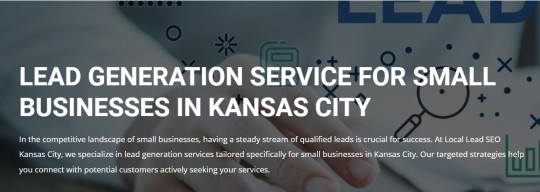
Understanding Website Optimization
Website optimization refers to the process of fine-tuning various elements of your site to ensure it operates efficiently, ranks well on search engines, and delivers an exceptional user experience. This involves a comprehensive approach that addresses loading speed, mobile responsiveness, search engine optimization (SEO), content quality, and overall usability.
Why Website Optimization Matters
Enhanced User Engagement: An optimized website fosters a seamless browsing experience, keeping visitors engaged longer and encouraging them to explore more pages.
Improved Search Engine Ranking: Search engines prioritize optimized websites in their results. By enhancing your site’s SEO, you increase its visibility, driving organic traffic and potential customers.
Faster Load Times: Website optimization directly affects loading speed. Users expect fast-loading pages, and delays can lead to high bounce rates and lost conversions.
Mobile Compatibility: With the growing number of mobile users, ensuring your website is mobile-friendly is essential. A responsive design guarantees a consistent experience across devices.
Higher Conversion Rates: Optimizing your website can guide visitors toward desired actions, such as making purchases or signing up for newsletters, ultimately boosting your conversion rates.
Key Strategies for Website Optimization
On-Page SEO Optimization
Keyword Integration: Perform keyword research to identify relevant terms your audience searches for. Incorporate these keywords naturally in your content, headings, and URLs.
Meta Tags and Descriptions: Write compelling title tags and meta descriptions that include keywords and summarize your content to improve click-through rates from search results.
Content Quality: Focus on creating valuable, informative content that resonates with your audience. High-quality content is more likely to be shared and linked to, improving your site's authority.
Speed Optimization Techniques
Image Optimization: Use tools to compress images without losing quality, ensuring faster loading times. Choose the right file format (JPEG, PNG, WebP) based on the type of image.
Browser Caching: Implement browser caching to store frequently accessed resources on users’ devices, significantly reducing load times for repeat visitors.
Minimize Code: Remove unnecessary HTML, CSS, and JavaScript to streamline your website’s code. Consider minifying your files to enhance loading speed.
Responsive and Mobile-Friendly Design
Fluid Grid Layouts: Use a fluid grid layout that adjusts elements according to screen size, ensuring a seamless experience for all users, regardless of device.
Touch-Friendly Elements: Design buttons and links that are easy to tap on mobile devices, enhancing navigation and usability.
Viewport Meta Tag: Include a viewport meta tag in your HTML to control layout on mobile browsers, ensuring a responsive design.
User Experience (UX) Improvements
Clear Navigation Structure: Organize your site’s navigation logically, making it easy for users to find what they need quickly.
Engaging CTAs: Use prominent and clear calls to action throughout your site to guide users toward desired actions, such as signing up or purchasing.
A/B Testing: Conduct A/B testing on different elements, such as CTAs, layouts, and content, to determine which versions yield the best results.
Technical SEO Best Practices
Create an XML Sitemap: Generate and submit an XML sitemap to search engines to help them crawl and index your site efficiently.
Implement Schema Markup: Use schema markup to provide search engines with additional context about your content, enhancing the appearance of your listings in search results.
Secure Your Site: Use HTTPS to secure your website, improving trust with users and potentially boosting your rankings on search engines.
Monitoring and Analytics
Utilize Analytics Tools: Implement tools like Google Analytics to track user behavior, traffic sources, and conversion rates. Use this data to identify areas for improvement.
Regular Audits: Conduct regular audits of your website to assess performance and usability. Identify and address any issues that may hinder user experience or SEO.
Conclusion
Website optimization is not a one-time effort but an ongoing process that requires regular attention and updates. By implementing the strategies outlined in this article, you can enhance your website’s performance, improve user experience, and increase visibility in search engine results. Remember, an optimized website not only attracts visitors but also converts them into loyal customers. Invest in website optimization today to ensure your online presence remains competitive and effective in achieving your business goals.
0 notes
Text
Everything to Consider Before Uninstalling WhatsApp

In today’s fast-paced digital world, WhatsApp has grown into a vital tool for staying connected. Whether it’s casual chats, important voice or video calls, or even handling business communications, millions of users globally depend on WhatsApp daily. It offers a convenient, real-time way to engage with friends, family, and colleagues. However, there may come a moment when you find yourself considering uninstalling or deleting the app entirely. This decision might stem from privacy concerns, a desire to reduce distractions, or even a switch to another messaging platform. But before making such a choice, it’s essential to carefully think about the potential pros and cons.
In this guide, we'll explore all the critical factors you should keep in mind before taking action, including how deleting and uninstalling WhatsApp are fundamentally different decisions.
Reasons for Uninstalling WhatsApp Account
There are several compelling reasons why users choose to uninstall WhatsApp, ranging from privacy concerns to digital overload.
1. Privacy Concerns
With growing worries about data privacy, many users are uncomfortable with WhatsApp’s data-sharing policies with its parent company, Meta. Uninstalling can offer peace of mind without permanently deleting your account.
2. Time Management
Constant notifications and messages can be distracting. Uninstalling WhatsApp can help individuals focus better on their tasks by reducing interruptions throughout the day.
3. Digital Detox
In an always-connected world, uninstalling WhatsApp allows users to take a break from social media and messaging platforms, helping to disconnect and reset without losing access to their data.
4. Switching to Alternative Platforms
Many people are turning to alternative messaging apps like Telegram or Signal, which promise enhanced privacy features and better control over data.
5. Reducing Phone Storage
WhatsApp media, including photos and videos, can quickly eat up storage space on your phone. Uninstalling the app helps clear up space temporarily.
6. Burnout from Constant Communication
For some users, the pressure to stay connected can lead to burnout. Uninstalling WhatsApp allows them to step back from social obligations and enjoy some personal space.
These reasons reflect the growing need for privacy, mental balance, and improved focus in the modern digital landscape.
Restoring WhatsApp Chats After Re-Installing WhatsApp
One of the biggest concerns when uninstalling WhatsApp is losing all your chats, photos, and media. Fortunately, WhatsApp offers a backup feature that allows you to restore your chat history after re-installation. Here’s how it works:
1. Cloud Backup
Before uninstalling WhatsApp, make sure you have a backup of your chat history on Google Drive (for Android) or iCloud (for iPhone). This backup includes all your messages, photos, and videos.
2. Restoring the Backup
Once you reinstall WhatsApp, it will prompt you to restore your chats from the backup. Simply follow the instructions, and all your previous messages and media will be restored.
3. Local Backup (Android Only)
WhatsApp also creates a local backup on your phone’s storage, which can be used to restore messages even without cloud backup.
Make sure you enable regular backups in WhatsApp’s settings to ensure you don’t lose any important conversations.
Deleting vs. Uninstalling WhatsApp
When considering stepping away from WhatsApp, it's important to understand the difference between deleting your account and simply uninstalling the app. These two actions have distinct consequences, and choosing the right one depends on your needs.
Uninstalling WhatsApp
Uninstalling WhatsApp is a temporary step. When you uninstall the app from your device, you are essentially removing the software without affecting your account. Your account remains active, meaning people can still send you messages, though you won’t receive them until you reinstall the app. Additionally, all your messages, photos, and videos are stored in backups (if enabled), making it easy to restore everything when you reinstall WhatsApp.
Deleting WhatsApp
Deleting WhatsApp is a more permanent decision. When you delete your account, all your data is erased, including your chat history, groups, profile picture, and account details. Once deleted, the process is irreversible, and you’ll need to create a new account if you decide to return. Deleting your account also removes you from any groups, and any messages you’ve sent will remain visible to others, but your profile will no longer exist.
Ultimately, the key difference is in permanence. Uninstalling gives you the flexibility to take a break without losing data while deleting is a final step that erases your account and all associated information. If you're unsure whether you want to part with WhatsApp permanently, uninstalling might be a better option. If you're certain about leaving the platform for good, then deleting your account is the way to go.
Benefits of Uninstalling WhatsApp
There are several advantages to uninstalling WhatsApp without permanently deleting your account. These benefits can help you decide whether a temporary uninstall is more suitable than a complete deletion.
1. Improved Focus
Uninstalling WhatsApp eliminates constant notifications, allowing you to focus more effectively on your tasks and minimizing daily distractions, helping you maintain better concentration throughout your day.
2. Digital Detox
Uninstalling the app allows you to take a temporary break from social media without losing any data. It’s an ideal solution for those looking to disconnect but not ready to delete their accounts permanently.
3. Privacy and Security
If you’re concerned about your privacy, uninstalling the app will ensure that it can no longer collect data from your device, as it’s no longer installed. Your account remains intact, but your phone no longer communicates with WhatsApp servers.
4. Reduced Phone Storage Usage
WhatsApp media (photos, videos, documents) can take up a significant amount of storage on your phone. Uninstalling the app helps free up space temporarily, which can be useful if you're running low on storage.
5. Easier Reconnection
The best part about uninstalling instead of deleting your account is that you can easily reinstall the app whenever you’re ready. All your contacts, chats, and media will still be there if you’ve backed them up correctly.
Uninstalling WhatsApp offers a flexible solution for those who need a break but aren’t ready for a permanent farewell.
Conclusion
Before deciding to uninstall WhatsApp, it’s crucial to consider the reasons behind your choice. Whether it's privacy concerns, the need for a digital detox, or simply wanting to try other apps, uninstalling WhatsApp can offer many benefits without the finality of account deletion. If you do uninstall, remember to back up your chats, so they can be restored later. Additionally, understanding the difference between uninstalling and deleting WhatsApp is key to making an informed decision.
Ultimately, uninstalling WhatsApp can be a healthy step toward better focus and time management, while still allowing you to reconnect when the time is right. Whether you're looking to step away for a short period or reconsider your use of messaging apps, uninstalling WhatsApp provides a balanced solution for those seeking flexibility.
1 note
·
View note
Text
Why Custom Web Design Is Better Than Templates
In a digital world, a website is often the first impression customers have of a business. It serves as a gateway to your brand, influencing how visitors perceive your services or products. Therefore, it's essential that your website stands out and provides an exceptional user experience. When it comes to building a website, businesses are often faced with two primary options: custom web design or using pre-made templates. While both approaches have their merits, custom web design offers significant advantages that make it a superior choice for many businesses.

1. Unique Brand Identity One of the most significant advantages of custom web design is the ability to create a website that reflects your unique brand identity. Templates, while convenient, tend to limit your creativity to predefined layouts and features. This can result in a website that looks similar to countless others on the web, which can dilute your brand’s individuality. With custom web design, you have the freedom to design every aspect of your site from scratch, ensuring that it aligns with your brand’s aesthetics, values, and message. Colors, fonts, and imagery are tailored specifically to your business, making your website an extension of your brand. This uniqueness not only makes a lasting impression on visitors but also strengthens brand recognition.
2. Better User Experience User experience (UX) plays a critical role in the success of any website. If visitors find your website difficult to navigate or slow to load, they're likely to leave and never return. Templates are often designed with a one-size-fits-all mentality, which means they may not be optimized for your specific audience or content needs. Custom web design allows you to tailor the layout and functionality of your website to deliver a seamless user experience. You can design navigation paths that make sense for your visitors, ensuring that they can easily find the information they need. Additionally, custom websites can be optimized for speed, ensuring that your site loads quickly and provides a smooth browsing experience. This level of optimization is difficult to achieve with a template that comes with unnecessary features and code bloat.
3. Scalability and Flexibility As your business grows and evolves, your website should be able to adapt to new challenges and opportunities. Templates are often limited in terms of scalability and customization, meaning you may eventually outgrow your website or face difficulties when trying to add new features. Custom web design, on the other hand, offers unparalleled flexibility. Since the site is built from the ground up, it can be easily modified to accommodate new business needs. Whether you're looking to add e-commerce functionality, integrate a customer management system, or incorporate interactive features, a custom site provides the foundation to grow and evolve as your business does.
4. Enhanced SEO Capabilities Search engine optimization (SEO) is essential for any business looking to attract traffic to its website. While some templates claim to be SEO-friendly, they often lack the flexibility to make the nuanced changes necessary for optimal search engine rankings. Template designs may also come with pre-built code that isn’t well-optimized, which can slow down your site and negatively affect its SEO performance. Custom web design allows for a clean, streamlined codebase tailored specifically for SEO. With full control over the structure of your website, you can implement best practices for on-page SEO, such as optimizing URLs, meta tags, headers, and image alt text. Moreover, custom websites are built with mobile-first indexing in mind, ensuring that they perform well on mobile devices, which is a key factor in search engine rankings.
5. Security and Support When using a template, you're reliant on the developer of that template for updates and security patches. If the developer discontinues support or fails to address security vulnerabilities, your site could be at risk of hacking or malware. Templates are also more prone to security risks because their widely available code can be targeted by hackers who know how to exploit common vulnerabilities. Custom web design offers a more secure solution because it is built with your business’s specific needs in mind. Custom-built websites are harder for hackers to breach because the code is unique and not widely available. Additionally, you can ensure that your custom website receives ongoing updates and maintenance, providing peace of mind that your site is secure and performing optimally.
Conclusion: While templates may offer convenience and lower upfront costs, they often fall short in providing the customization, scalability, and performance that modern businesses need. Custom web design allows you to build a unique, optimized, and future-proof website that aligns with your brand’s vision and goals. By investing in a custom website, you ensure that your online presence stands out, engages your audience, and supports your business’s growth over the long term.
#web designing#website design company in nagpur#web page design#web designing in nagpur#web design company in nagpur
0 notes
Text
Deploying AI at Scale: How NVIDIA NIM and LangChain are Revolutionizing AI Integration and Performance
New Post has been published on https://thedigitalinsider.com/deploying-ai-at-scale-how-nvidia-nim-and-langchain-are-revolutionizing-ai-integration-and-performance/
Deploying AI at Scale: How NVIDIA NIM and LangChain are Revolutionizing AI Integration and Performance
Artificial Intelligence (AI) has moved from a futuristic idea to a powerful force changing industries worldwide. AI-driven solutions are transforming how businesses operate in sectors like healthcare, finance, manufacturing, and retail. They are not only improving efficiency and accuracy but also enhancing decision-making. The growing value of AI is evident from its ability to handle large amounts of data, find hidden patterns, and produce insights that were once out of reach. This is leading to remarkable innovation and competitiveness.
However, scaling AI across an organization takes work. It involves complex tasks like integrating AI models into existing systems, ensuring scalability and performance, preserving data security and privacy, and managing the entire lifecycle of AI models. From development to deployment, each step requires careful planning and execution to ensure that AI solutions are practical and secure. We need robust, scalable, and secure frameworks to handle these challenges. NVIDIA Inference Microservices (NIM) and LangChain are two cutting-edge technologies that meet these needs, offering a comprehensive solution for deploying AI in real-world environments.
Understanding NVIDIA NIM
NVIDIA NIM, or NVIDIA Inference Microservices, is simplifying the process of deploying AI models. It packages inference engines, APIs, and a variety of AI models into optimized containers, enabling developers to deploy AI applications across various environments, such as clouds, data centers, or workstations, in minutes rather than weeks. This rapid deployment capability enables developers to quickly build generative AI applications like copilots, chatbots, and digital avatars, significantly boosting productivity.
NIM’s microservices architecture makes AI solutions more flexible and scalable. It allows different parts of the AI system to be developed, deployed, and scaled separately. This modular design simplifies maintenance and updates, preventing changes in one part of the system from affecting the entire application. Integration with NVIDIA AI Enterprise further streamlines the AI lifecycle by offering access to tools and resources that support every stage, from development to deployment.
NIM supports many AI models, including advanced models like Meta Llama 3. This versatility ensures developers can choose the best models for their needs and integrate them easily into their applications. Additionally, NIM provides significant performance benefits by employing NVIDIA’s powerful GPUs and optimized software, such as CUDA and Triton Inference Server, to ensure fast, efficient, and low-latency model performance.
Security is a key feature of NIM. It uses strong measures like encryption and access controls to protect data and models from unauthorized access, ensuring it meets data protection regulations. Nearly 200 partners, including big names like Hugging Face and Cloudera, have adopted NIM, showing its effectiveness in healthcare, finance, and manufacturing. NIM makes deploying AI models faster, more efficient, and highly scalable, making it an essential tool for the future of AI development.
Exploring LangChain
LangChain is a helpful framework designed to simplify AI models’ development, integration, and deployment, particularly those focused on Natural Language Processing (NLP) and conversational AI. It offers a comprehensive set of tools and APIs that streamline AI workflows and make it easier for developers to build, manage, and deploy models efficiently. As AI models have grown more complex, LangChain has evolved to provide a unified framework that supports the entire AI lifecycle. It includes advanced features such as tool-calling APIs, workflow management, and integration capabilities, making it a powerful tool for developers.
One of LangChain’s key strengths is its ability to integrate various AI models and tools. Its tool-calling API allows developers to manage different components from a single interface, reducing the complexity of integrating diverse AI tools. LangChain also supports integration with a wide range of frameworks, such as TensorFlow, PyTorch, and Hugging Face, providing flexibility in choosing the best tools for specific needs. With its flexible deployment options, LangChain helps developers deploy AI models smoothly, whether on-premises, in the cloud, or at the edge.
How NVIDIA NIM and LangChain Work Together
Integrating NVIDIA NIM and LangChain combines both technologies’ strengths to create an effective and efficient AI deployment solution. NVIDIA NIM manages complex AI inference and deployment tasks by offering optimized containers for models like Llama 3.1. These containers, available for free testing through the NVIDIA API Catalog, provide a standardized and accelerated environment for running generative AI models. With minimal setup time, developers can build advanced applications such as chatbots, digital assistants, and more.
LangChain focuses on managing the development process, integrating various AI components, and orchestrating workflows. LangChain’s capabilities, such as its tool-calling API and workflow management system, simplify building complex AI applications that require multiple models or rely on different types of data inputs. By connecting with NVIDIA NIM’s microservices, LangChain enhances its ability to manage and deploy these applications efficiently.
The integration process typically starts with setting up NVIDIA NIM by installing the necessary NVIDIA drivers and CUDA toolkit, configuring the system to support NIM, and deploying models in a containerized environment. This setup ensures that AI models can utilize NVIDIA’s powerful GPUs and optimized software stack, such as CUDA, Triton Inference Server, and TensorRT-LLM, for maximum performance.
Next, LangChain is installed and configured to integrate with NVIDIA NIM. This involves setting up an integration layer that connects LangChain’s workflow management tools with NIM’s inference microservices. Developers define AI workflows, specifying how different models interact and how data flows between them. This setup ensures efficient model deployment and workflow optimization, thus minimizing latency and maximizing throughput.
Once both systems are configured, the next step is establishing a smooth data flow between LangChain and NVIDIA NIM. This involves testing the integration to ensure that models are deployed correctly and managed effectively and that the entire AI pipeline operates without bottlenecks. Continuous monitoring and optimization are essential to maintain peak performance, especially as data volumes grow or new models are added to the pipeline.
Benefits of Integrating NVIDIA NIM and LangChain
Integrating NVIDIA NIM with LangChain has some exciting benefits. First, performance improves noticeably. With NIM’s optimized inference engines, developers can get faster and more accurate results from their AI models. This is especially important for applications that need real-time processing, like customer service bots, autonomous vehicles, or financial trading systems.
Next, the integration offers unmatched scalability. Due to NIM’s microservices architecture and LangChain’s flexible integration capabilities, AI deployments can quickly scale to handle increasing data volumes and computational demands. This means the infrastructure can grow with the organization’s needs, making it a future-proof solution.
Likewise, managing AI workflows becomes much simpler. LangChain’s unified interface reduces the complexity usually associated with AI development and deployment. This simplicity allows teams to focus more on innovation and less on operational challenges.
Lastly, this integration significantly enhances security and compliance. NVIDIA NIM and LangChain incorporate robust security measures, like data encryption and access controls, ensuring that AI deployments comply with data protection regulations. This is particularly important for industries like healthcare, finance, and government, where data integrity and privacy are paramount.
Use Cases for NVIDIA NIM and LangChain Integration
Integrating NVIDIA NIM with LangChain creates a powerful platform for building advanced AI applications. One exciting use case is creating Retrieval-Augmented Generation (RAG) applications. These applications use NVIDIA NIM’s GPU-optimized Large Language Model (LLM) inference capabilities to enhance search results. For example, developers can use methods like Hypothetical Document Embeddings (HyDE) to generate and retrieve documents based on a search query, making search results more relevant and accurate.
Similarly, NVIDIA NIM’s self-hosted architecture ensures that sensitive data stays within the enterprise’s infrastructure, thus providing enhanced security, which is particularly important for applications that handle private or sensitive information.
Additionally, NVIDIA NIM offers prebuilt containers that simplify the deployment process. This enables developers to easily select and use the latest generative AI models without extensive configuration. The streamlined process, combined with the flexibility to operate both on-premises and in the cloud, makes NVIDIA NIM and LangChain an excellent combination for enterprises looking to develop and deploy AI applications efficiently and securely at scale.
The Bottom Line
Integrating NVIDIA NIM and LangChain significantly advances the deployment of AI at scale. This powerful combination enables businesses to quickly implement AI solutions, enhancing operational efficiency and driving growth across various industries.
By using these technologies, organizations keep up with AI advancements, leading innovation and efficiency. As the AI discipline evolves, adopting such comprehensive frameworks will be essential for staying competitive and adapting to ever-changing market needs.
#ai#AI development#ai inference#AI integration#AI models#ai tools#API#APIs#applications#architecture#artificial#Artificial Intelligence#autonomous#autonomous vehicles#avatars#bots#Building#chatbots#Cloud#clouds#complexity#compliance#comprehensive#Containers#continuous#conversational ai#CUDA#CUDA Toolkit#customer service#cutting
0 notes
Text
A Quick Review Of The 7 Platform Business Articles Among The 10 Most Cited Articles In 2023 In The Strategic Management Journal
A quick review of the 7 most cited articles on platform businesses (also called ibusinesses or more generally known to the public as apps and digital business) which are quite popular in strategy science these days.
This is unsurprising given the proliferation of many successful platform businesses from Google to Facebook to Tiktok to Alibaba over the past 2 decades. A lot of contemporary research has been focused on analysing these businesses to try to understand in detail how they work and what are the ingredients that facilitate business success.
Platform ecosystems as meta-organizations: Implications for platform strategies – Tobias Kretschmer, Aija Leiponen, Melissa Schilling, Gurneeta Vasudeva
This is an special feature introductory review of the meta-organisational features of platform ecosystems. It is interesting to me because it focuses on areas such as motivation, authority and governance, which are not that well understood yet.
Liminal movement by digital platform-based sharing economy ventures: The case of Uber Technologies – Raghu Garud, Arun Kumaraswamy, Anna Roberts, Le Xu
This is the famous case study of Uber. I have read it a few times previously.
It is basically describing the marketing and PR of Uber as it navigates governments. The authors focused on the non market strategies of Uber and found that Uber used a series of interrelated market and nonmarket strategies, which they label as liminal movement, to generate cognitive and sociopolitical legitimacy as it disrupted the taxi industry worldwide a decade ago.
Mutualism and the dynamics of new platform creation: A study of Cisco and fog computing – Saeed Khanagha, Shahzad (Shaz) Ansari, Sotirios Paroutis, Luciano Oviedo
This is an interesting case study of Fog and Cloud, 2 competing platform businesses involving Cisco. Cisco is a complementor (basically this means it is not the owner but a participant) on Cloud while on Fog it is the owner.
The authors developed a process model to reveal how a firm in a peripheral role in a platform ecosystem can reposition itself through a dynamic mix of material, symbolic and institutional actions to develop and legitimise an alternative platform.
User preferences and strategic interactions in platform ecosystems – Claudio Panico, Carmelo Cennamo
This is a study on ecosystem innovativeness (complement novelty and quality) vs ecosystem size (number of complementors/complements).
From proprietary to collective governance: How do platform participation strategies evolve? – Siobhan O’Mahony, Rebecca Karp
This is a study on how platform participants (also called complementors as above) adapt their strategies when a platform leader changes the rules governing access and control.
Platform governance matters: How platform gatekeeping affects knowledge sharing among complementors – Yuchen Zhang, Jingjing Li, Tony W. Tong
This is a study on how gatekeeping affects complementors' knowledge sharing. The authors find causal evidence that a lapse in gatekeeping reduces knowledge sharing among iOS app developers and the effect is mitigated among developers with greater knowledge complexity but magnified among those with greater knowledge routineness.
Platforms for the people: Enabling civic crowdfunding through the cultivation of institutional infrastructure – Danielle Logue, Matthew Grimes
This is a case study of a civic crowdfunding platform drawing upon institutional theory where the authors created a process model of social-mission platform creation.
0 notes
Text
The Ultimate SEO Course 2024: Beginner to Advanced SEO

In today’s digital world, Search Engine Optimization (SEO) is essential for any online business to grow and succeed. As more businesses move online, mastering SEO techniques becomes even more critical. With constant updates from Google’s algorithm, professionals must stay current with the latest SEO trends and best practices. If you’re looking to enhance your skills or embark on a journey into the SEO world, then "The Ultimate SEO Course 2024: Beginner to Advanced SEO" is the perfect choice for you.
This comprehensive course covers everything from basic to advanced SEO strategies, helping learners grasp the complexities of SEO and ensuring that websites rank high on search engines.
Why SEO Matters in 2024
Search engines like Google are constantly evolving. With Google's algorithm updates happening more frequently, it’s vital to stay updated. In 2024, the key trends include focusing on core web vitals, mobile-first indexing, voice search optimization, and AI-driven SEO. The Ultimate SEO Course 2024 addresses these emerging trends, ensuring that learners stay ahead of the curve.
What You’ll Learn in "The Ultimate SEO Course 2024: Beginner to Advanced SEO"
This course is meticulously designed to guide you from the fundamentals to more intricate SEO strategies. Here's what you will explore:
1. Introduction to SEO
The course begins with an introduction to what SEO is, its importance, and how search engines work. You will get an overview of search engine ranking factors, the difference between on-page SEO and off-page SEO, and why they are essential for achieving high rankings on Google.
2. Keyword Research
One of the most crucial components of SEO is keyword research. Understanding which keywords your target audience is searching for is vital for driving organic traffic to your website. The course will show you how to use tools like Google Keyword Planner, SEMrush, and Ahrefs to identify high-traffic keywords that are relevant to your niche. You’ll also learn how to differentiate between short-tail keywords and long-tail keywords and how to incorporate them into your SEO strategy.
In 2024, there’s an increased emphasis on user intent. Google wants to deliver the most relevant results, so it’s not just about keyword density anymore; it’s about understanding what the searcher wants and delivering that.
3. On-Page SEO Optimization
On-page SEO refers to all the elements you can control on your website to improve its ranking on search engines. This includes optimizing meta tags, headings, content, and images. You’ll also learn how to write SEO-friendly content that both search engines and users love. The course will teach you the significance of internal linking and URL structure, and how to optimize your site for core web vitals, which are critical ranking factors in 2024.
Heading structure (H1, H2, H3) is another important factor in on-page SEO. It helps Google understand the hierarchy and relevance of your content. Additionally, you'll discover the importance of creating SEO-friendly content that incorporates LSI (Latent Semantic Indexing) keywords to improve the relevance of your site.
4. Technical SEO
Technical SEO is the backbone of your website’s search engine performance. This module covers everything from site speed optimization to mobile responsiveness, structured data markup, and XML sitemaps.
In 2024, mobile-first indexing is no longer a trend but a standard practice. Therefore, the course emphasizes optimizing your website for mobile users, ensuring it is responsive and fast-loading. Core web vitals, which include Largest Contentful Paint (LCP), First Input Delay (FID), and Cumulative Layout Shift (CLS), will be a focus, helping you understand how they affect your SEO rankings.
5. Off-Page SEO
Off-page SEO involves everything outside your website that affects your search rankings. The Ultimate SEO Course 2024 will dive deep into link-building strategies that still work in 2024. You will learn about acquiring high-quality backlinks from authoritative websites, engaging in guest blogging, and building relationships with influencers to enhance your site’s credibility.
The course also covers social media marketing and local SEO, highlighting the importance of social signals and citations from local directories.
6. SEO for E-Commerce
In 2024, e-commerce SEO is more important than ever. This course covers strategies specific to online stores, such as optimizing product pages, improving category pages, and creating compelling product descriptions. You will also learn about schema markup for products and how to optimize for Google Shopping.
7. Voice Search Optimization
With the rise of voice assistants like Siri, Alexa, and Google Assistant, optimizing for voice search is crucial in 2024. This course teaches you how to adapt your SEO strategies to cater to voice search queries, which are often longer and more conversational.
8. Content Marketing and SEO
Content is king, and content marketing plays a massive role in driving traffic to your site. You will learn how to create content that ranks, from blog posts and pillar pages to video SEO and infographics. The course will show you how to use Google Trends and SERP analysis to stay updated on content ideas that are popular in your niche.
9. Tracking and Analytics
SEO is not a one-time job. To ensure continued success, you need to track your performance. This course will guide you through using tools like Google Analytics, Google Search Console, and Ahrefs to monitor your traffic, backlinks, and overall SEO health. You’ll learn how to measure organic traffic, bounce rates, and conversion rates to refine your strategy continuously.
Top SEO Keywords for 2024
Here are some of the top SEO keywords to focus on in 2024, many of which are covered in detail in the Ultimate SEO Course 2024. Understanding and incorporating these into your strategy will ensure your content remains relevant and optimized.
SEO best practices
SEO trends 2024
Core web vitals
Voice search optimization
Google algorithm updates
Mobile-first indexing
AI-driven SEO
Long-tail keywords
On-page SEO strategies
Technical SEO audit
These keywords, along with others identified using SERP analysis and Google Keyword Planner, can boost your site's performance if used effectively.
Who Should Take This Course?
"The Ultimate SEO Course 2024: Beginner to Advanced SEO" is perfect for:
Beginners looking to get into SEO and digital marketing.
Small business owners who want to drive organic traffic to their websites.
Content creators and bloggers looking to rank higher in search engines.
Marketing professionals who want to add SEO to their skill set.
SEO practitioners looking to stay updated with the latest SEO techniques.
Why Choose "The Ultimate SEO Course 2024: Beginner to Advanced SEO"?
This course is designed by industry experts with years of experience in SEO and digital marketing. You will receive real-world case studies, hands-on exercises, and access to the latest SEO tools and techniques. The 2024 SEO Course is also updated regularly to keep up with Google’s frequent algorithm changes.
Conclusion
SEO is an ever-evolving field, and staying updated with the latest trends and practices is vital for your online success. Whether you’re a beginner or looking to refine your advanced skills, "The Ultimate SEO Course 2024: Beginner to Advanced SEO" offers everything you need to achieve higher rankings, increased traffic, and improved conversion rates.
Start your SEO journey today and stay ahead of the competition with the most comprehensive and up-to-date SEO course for 2024.
0 notes